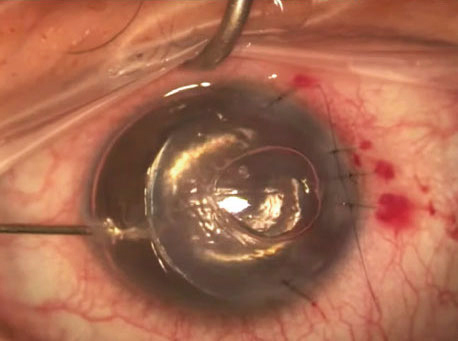 |
| Although DSEK has proven itself to be a quantum leap up from penetrating keratoplasty, endothelial cell loss remains a concern. Image courtesy of James Lewis, MD. Click image to enlarge. |
Several different options are available to treat corneal endothelial dysfunction, and techniques continue to evolve for these procedures. A recent study considered 10-year outcomes following Descemet stripping endothelial keratoplasty (DSEK) and found a high rate of graft survival at 79%, including patients with complex grafts.
Additionally, the UK investigation reported an endothelial cell loss (ECL) of 73% at the 10-year mark, while low-risk Fuchs’ endothelial dystrophy grafts showed a 92% survival rate over the same period.
“We propose that long-term prescribing of topical corticosteroids combined with early treatment of graft rejection contribute to reducing ECL and increased graft survival,” the authors wrote in their paper.
The study analyzed the results of 356 consecutive DSEK grafts performed by 10 surgeons who used a standard protocol technique. The investigation’s primary outcomes were cumulative graft survival and ECL from six months to 10 years, while secondary outcomes included risk factors for graft failure, postoperative complications, visual outcomes and central corneal thickness.
Indications included 209 Fuchs’ endothelial dystrophy and 88 bullous keratopathy cases, 39 previous graft failures and 104 eyes with preoperative glaucoma. Cumulative graft survival rates in all eyes were 97% at one year, 90% at three years, 85% at five years and 79% at the 10-year study endpoint.
Considering topical steroid drops, the investigators suggested using long-term alternate-day dexamethasone 0.1% offers an optimum balance between reducing the graft rejection risk and minimizing steroid-associated complications.
The percentage of ECL loss of all grafts was 46.6±17.3 at year one, 54.9±18.7 at year three, 59.6±17.4 at year five and 73.1±9.7 at 10 years. Despite a 10-year endothelial cell count of only 692 cells/mm2, graft survival remained high with good vision, the authors said.
Also of note: the researchers found that preoperative glaucoma, previous glaucoma surgery and regrafts were significant risk factors for graft failure.
DSEK remains a viable treatment option, especially in complex eyes with comorbidity, and outcomes can be maximized with a standardized protocol, the authors concluded.
Fu L, Hollick E. Long-term outcomes of Descemet stripping endothelial keratoplasty: ten-year graft survival and endothelial cell loss. Am J Ophthalmol. August 17, 2021. [Epub ahead of print]. |

